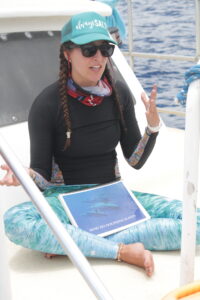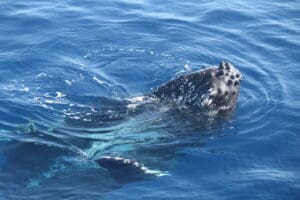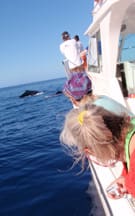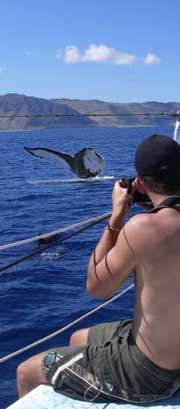How to Choose a Whale Watch or Dolphin Tour – Whale Watching Facts
From savvy and sophisticated travelers seeking a conscious experience, to families wanting an adventure both exciting and educational, which whale watch facts do we consider to be safe, sane and optimal for both us and the animals we seek to connect with?
• What training has the crew had, specifically, the people who will interact with guests and guide the tour? Ask specifically about training, study, research participation or length of experience observing whales.
• Is whale watching a primary focus for this boat? Many companies run seasonal whale watches in addition to other business, such as scuba diving or fishing. Be sure the cruise you select is marine wildlife focused (not a fly-by glimpse as you head off elsewhere). Do they do offer whale-watching every season and actually devote time and energy to studying whales?
• How long has the boat company been in business? Is this a reputable operator? Does the company respect whale watching facts and guidelines? Do smaller boats honor advertised “maximum” passenger load ? Beware companies promising, the “closest you’ll ever get.” That may well be a sign that are not respecting whale watch guidelines, laws or the whales behavior. Make certain that you will not be surprised when you arrive at the dock of a less-known company and find your boat overflowing at the seams with “last minute add-on” passengers. It can mean the difference between first class seats on the airplane and riding a bus at rush hour.
• The boat captain and naturalist are key All the technology in the world can’t make up for experience on the water. Your chance for getting up close and personal with humpback whales really hinges on the ability of the crew to find them. And having a knowledgeable naturalist ensures you are not only seeing whales, and hearing factoids, but learning about them and the behaviors you are observing.
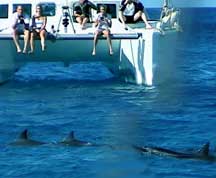
Zodiacs (inflatable rafts) are quick and for the rough and ready. They are not for everyone however. Pregnant women or those with bad backs should consider a less concussive, and more stable vessel.
Smaller boats and/or group sizes offer more attention to each guest, and a more intimate experience with every animal encountered.
• How is the boat set up? Does it offer comfortable (dry?) seating for watching whales? Is shade available for tender-skinned visitors? Is there a bathroom on board? Is it propelled by engines that whales may find disturbing? We strongly suggests taking a good look at boats with both whale-watching and sea-worthiness in mind. For instance, check the ratio of passengers to boat size. “Small groups” may indeed be a true statement for a small boat that is overcrowded with passengers. However walking freely on a stable larger boat may suit you better than sitting elbow-to-elbow with passengers confined on a smaller vessel (especially if one or more get sea-sick!).
• Does the boat carry hydrophones so you can listen to whale song? This is one benefit that you may not have thought about, once heard, whale song will haunt you for the rest of your life.
• What’s included in the price of the cruise? — Snacks? breakfast? lunch? drinks? How long will you be out? On some cruises, food and beverages may be included in the price or are for sale. If for sale, prices may be steep. You also may want access to bathroom facilities – and shade!
• Do they guarantee a whale sightings? Those concerned about whales say guarantees may cause captains to chase whales or whale watch in impacted areas- already having too many boats. Guarantees can put pressure on both operators and whales. Some feel the point should be to enjoy the day and whatever reveals itself.
How close will you get to the whales? Even “slow” boats may have a whale pop up in front of them, and whales suffer boat strikes annually. “Closest you’ll ever get” may be a claim you’ll wish you didn’t receive!
• How much does the whale watch cost? Cost must be weighed against other factors, including those outlined above. Check prices in ratio to trip length and inclusions, “Bargains” or most bang for your buck may not the best deal after all. While you’re in line for your buffet lunch and watching girls coconut bras dance – you may miss that whale spout off in the distance. Consider though that “fast boats” (jet engines, outboard motors) may not only be a nuisance to the whales, but may “miss” or pass by whales that temporarily dive underwater alarmed by the noise .
• Do any proceeds from the whale watch benefit whale protection or research? Companies with a vested interest in the resource, (in a perfect world) should be just as concerned with conservation and education of the same resources they are exploiting. Wild Side tours employ conservation photography on all tours.
Dolphin and Whale Watching Facts
From December to May, Hawaii is one of the greatest destinations in the world to see humpback whales – and the US breeding grounds. While there are a few excellent whale-watching companies on Oahu, choosing the one that’s best for you depends on factors like health issues, comfort, and good old-fashioned personal preference.
Don’t Get Green!
If you’re prone to motion sickness, choose an early trip. In the islands, the wind almost always picks up as the day progresses and can cause choppiness and rougher seas. It also makes it more difficult for the whale watchers to
locate the whales. If you do decide to take something, like Dramamine® or Bonine®, check with your pharmacist, and find out if there are any complications with other drugs you may be taking. Take the medication at least a full hour before the trip. Eat lightly, avoid grease or fatty foods, alcohol and carbonated
beverages. A good nights sleep beforehand is always a plus.
Protect Those Baby Blues
Don’t forget the sunglasses and some sort of hat or visor to shade your eyes. The glare from the sun (even on cloudy days) can make it harder for you to see, and give you a headache if you’re squinting. Even if you are sitting in the shade, 60% of the sun’s rays bounce back up from the water’s surface. Go for polarized shades, they make a world of difference!
Slap on the Stuff
Sunblock is a must, no matter what time of year it is. Put it on ahead of time, it takes 20 minutes to set in, and not wash off onto coral reefs.
To Scan or Not to Scan
Binoculars are always helpful, but unless you’re a very experienced whale watcher or you’re watching from a land lookout, they’ll just get in the way. Looking through them is tough in the open ocean, and trying to focus with all the bouncing going on will probably give you a headache.
To Shoot or not to Shoot
Bring the camera, but by all means, don’t spend all your time looking through the lens. You’ll miss too much because your field of focus will be so much smaller. First, enjoy the sights and then try to get a few good shots. Chances are unless you’re a pro, you’ll end up with a lot of water shots. Keep the kiddies entertained Young children can get quite bored when whale watching, so bring along something to entertain them. Tracking whales is tough for anyone, let alone a child, who has a short attention span. (Remember, on the average, whales stay down for up to five minutes!) Choose a boat where your child can see off both sides from their seat.
ALSO
- Bring a (rain?) jacket or windbreaker. Regardless of how warm it is on the dock, it can get cooler on the water.
- Bring a camera with a long lens capable of fast shutter speeds. A waterproof camera bag is useful for avoiding sea spray or sprinkles.
- Learn to tell directions on the boat by using the hour system. This is how the naturalist will inform you of whale sightings. For example: “Spout at 3 o’clock!” or “Breach at 10 o’clock!”
Although our sighting rates are at 95+% we cannot guarantee sightings, interaction with wild dolphins, whales, snorkeling, nor ideal weather conditions. We reserve the right to not facilitate in-water OR shipboard encounters which we feel may compromise the well-being of our guests or ocean wildlife. All passengers are required to wear locator/flotation devices. We do not offer transportation to the boat harbors.
Wild Side adheres to the WCA Global Best Practice Guidance Whale Watch minimizing the risks of adverse impacts of whale watching.


